Publications
There are 35 results.
KV-FTI - Combined freight traffic - revealing the future potentials of research and innovation
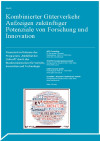
Combined transport (CT) is an environmentally sensible and politically desired traffic, which is struggling with cost problems due to complicated supply chains. Previous innovations in CT have focused much on the development of new transhipment technologies. These innovations were very expensive and resulted in the medium term partly to a further increase in the cost of the supply chain. The intention of this study includes a redesign of the transport and business processes, the compatibility of interfaces (with orientation towards homogenization and standardization) for the individual actors and an adapted technological development of intermodal transport containers (containers, SAL, WAB).
06/2014
DI Alexander Chloupek (ABC Consulting)
Publisher: BMVIT
German, 50 pages
Publication Downloads
INCOM-F - Austrian RTI-competences at the interface of freight transport and logistics
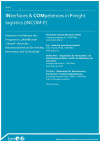
The study "INCOM-F" aimed to reduce the complexity between the actors (transport action and transport performance) of the freight mobility as well as to analyse its challenges (e.g. technical barriers as incompatible transport systems, lacking interoperability, different data formats etc.). The therefrom obtained results, allow the contracting entity to identify the most important actors and hence address promising RTI-topics in future national research calls.
07/2014
Dr. Sandra Stein, Dipl.-Ing. Georg Brunnthaller; Dipl.-Ing. Dr. rer. nat. Heinz Dörr; et al.
Publisher: BMVIT
German, 152 pages
Publication Downloads
New ways of expiriencing mobility through Research, Technology and Innovation
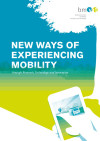
Social, economic and technological developments are placing increasingly more complex demands on the transport system and its capacity. New tech-nologies and innovations can significantly contribute to shaping sustainable mobility. They play an indispensable part in facing the major societal challenges such as climate change, scarcity of resources and demographic change and open up new economic opportunities for the transport sector, one of the most important economic branches in Austria
Evelinde Grassegger, Andreas Dorda, Sarah Krautsack (BMVIT)
Publisher: BMVIT
English, 15 pages
Publication Downloads
MobLab Study – Begleitstudie zur Vorbereitung urbaner Mobilitätslabore
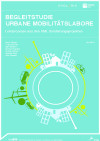
The MobLab Study supports the exploration of emerging urban mobility laboratories in Austria, in order to reduce the gap between the research results of the rigid environment of a laboratory and the implementation practice by offering a targeted accompanying of new Living Labs as user centred innovation settings as well as an evaluation of the gained insights.
Martin Berger, Linda Dörrzapf, Gert Breitfuß, Michael Poglitsch, Andrea Stickler, Vanessa Sodl, Elias Remele
Publisher: BMVIT
German, 53 pages
Publication Downloads
MANEUVER - Development of avoidance measures for misconduct on railway crossings with the aid of the traffic psychology
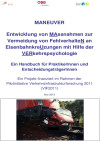
The objective of the project was to develop cost-effective measures (education, awareness-raising, roadside infrastructure) with the help of experts and road traffic participants to reduce misdemeanour at level crossings. Traffic psychological research methods will be adopted.
Mag. Eva Aigner-Breuss, DI Michael Aleksa, Dr. Eveline Braun, DI Klaus Machata, et al.
Publisher: BMVIT
German, 131 pages
Publication Downloads
LARA - Low noise tyres for quiet streets
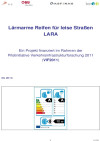
The objective of the project was to apply the EU regulations 2009/661/EC (contains new tyre noise limits) and 2009/1222/EC (noise labelling of tyres) to Austrian conditions in order to find the actual feasible noise reduction, as well as suggestions of how to adapt the Austrian calculation basis.
DI Manfred Haider, DI Reinhard Wehr, Dott. Ing. Marco Conter, Ing. Gerhard Strohmayer, DI Heinz Hoislbauer
Publisher: BMVIT
German, 74 pages
Publication Downloads
IND4LOG4 - Industry 4.0 and its impacts on the transport logistics
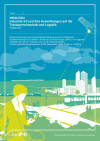
The proposed study analysed the impact of Industry 4.0 on the transport and logistics sector, also with regard to the foreign trade links of the Austrian economy. This analysis therefore offers a sound basis for the formulation of differentiated economic and transport policy recommendations as well as strategic recommendations.
Mag. Wolfgang Lueghammer, Mag.(FH) Wilhelm Schachinger, Mag. Dr. Wolfgang Schwarzbauer, et al.
Publisher: BMVIT
German, 117 pages
Publication Downloads
Mobility of the Future - Preliminary Results Mobility of Goods

From 2012 to 2016, BMVIT supported 62 logistics research projects with a total of EUR 12.8 million. This brochure gives you an overview of the projects completed so far and the national and European activities in which BMVIT is involved.
Sarah Krautsack (BMVIT)
Publisher: Federal Ministry of Transport, Innovation and Technology
English, 96 pages
Publication Downloads
Mobility of the Future – Preliminary Results Mobility of Persons
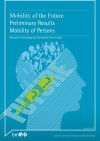
The publication provides an overview on research projects and activities between 2012 and 2016. About 100 projects have been funded and financed by BMVIT amounting 20 Mio. € in total.
DI Walter Wasner
Publisher: Bundesministerium für Verkehr, Innovation und Technologie – BMVIT
English, 128 pages
Publication Downloads
Safe Guarding - Potential of lateral road restraint systems on road safety capacity in the motor- and expressway network of the ASFiNAG
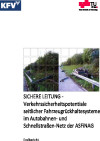
Run off accidents with personal injuries are the second most frequent type of accidents on the ASFiNAG road network. Road Restraints are an important instrument to reduce accident severity. For that reason the efficiency of these systems was analysed, in order to insure an efficient road maintenance regarding infrastructure costs and to reduce furthermore the severity of these accidents.
DI Manuel Pröll, DI Bernd Strnad, DI Dr.techn. Ernst Tomasch
Publisher: BMVIT
German, 102 pages
Publication Downloads
SynArea – Synergetic area coverage by public transport and low-threshold short trip-private transport
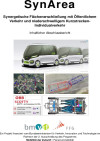
The aim of the project is the coverage of rural and/or suburban regions with multimodal services, which are more attractive for customers and economically more efficient than conventional public transport, accessed by foot, bike&ride or park&ride, and at the same time ecologically and socially more sustainable, than the sole use of motorised individual transport.
Harald Buschbacher, Gerald Kelz, Edith Hartmann, Stefan Kirschbichler, Christian Obermayer
Publisher: BMVIT
German, 232 pages
Publication Downloads
WIFAS - The Assessment of social impacts of funding programmes that support research in the mobility of people and goods
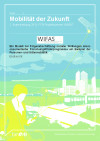
The aim of the WIFAS study is to develop a conceptually and empirically sound model to capture the social effects and/or impacts caused by subsidy programmes –Thus, by working out appropriated indicators and by conceiving a rating system which is suitable fort he analysis of a variety of impact dimensions, with special emphasis on ecological effects.
Mag. Peter Kaufmann, Laurenz Wolf, MSc, Mag. Alex Schubert, Dr. Alexander Neumann
Publisher: BMVIT
German, 154 pages
Publication Downloads
Shear area model - Mechanically consistent shear area-model for existing bridges without or with small lateral force reinforcement
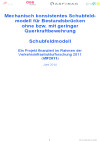
Within the scope of this research project a mechanically consistent model for the shear resistance of bridges without or low shear reinforcement was developed.
Dipl.-Ing. Patrick Huber, Univ.-Prof. Dr.Ing. Johann Kollegger, Univ.-Prof. Dr.Ing. Viet Tue Nguyen, Dr.-Ing. Duc Tung Nguyen
Publisher: BMVIT
German, 251 pages
Publication Downloads
RISKANT – Risk model for the analysis of accidents with stationary obstacles on highways und expressways
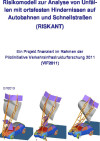
The objective of the RISKANT study was the development of a risk model for crashes with stationary obstacles along the road.
Priv.-Doz. DI Dr. Peter Maurer, DI Christian Stefan, DI Rainer Stütz, DI Dr. Ernst Tomasch, DI Peter Luttenberger, DI Christoph KleinN, Thomas Pistotnik
Publisher: BMVIT
German, 158 pages
Publication Downloads
The Drive to Walk: Identifying Milieu-based Persuasion Strategies for Motivating Active Mobility

11th International Conference on Persuasive Technology (Persuasive Technology 2016), Workshop Empowering Cities for Sustainable Wellbeing, Salzburg, Austria
Millonig, A., Markvica, K., Haufe, N.
Publisher: Springer - Verlag Berlin Heidelberg 2011
English, 11 pages
